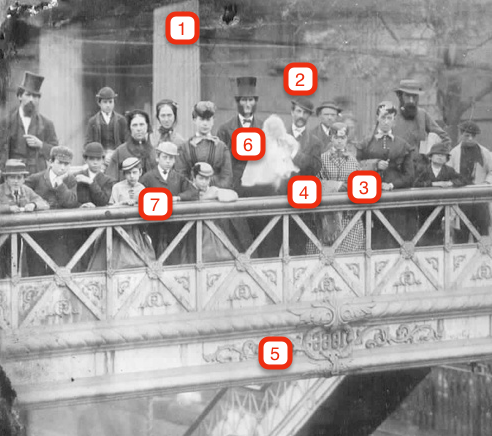Sign up for the Family Tree Newsletter Plus, you’ll receive our 10 Essential Genealogy Research Forms PDF as a special thank you!
Get Your Free Genealogy Forms
"*" indicates required fields
Genealogists know brick walls aren’t torn down over night. It took Janet Meleney nine years to scale the wall in front of this photograph, which she submitted to the Photo Detective column in 2002. At that time, Meleney believed the two little girls dressed identically were Carrie Ella Coit (1858-1934) and C. Miriam Coit (1856-1921). Behind them, Meleney believed, was their mother Ellen Nafie Coit (1827-1893). I was able to confirm these identities by matching up facial features I saw in additional photographs Meleney had sent.
I was also able to confirm the image was taken in the late 1860s, but I didn’t know anything about the bridge the Coits are standing on. I featured the photo in a short online piece hoping that someone would recognize it.
Recently, Meleney made a chance discovery in the New York Public Library digitized collections, and identified the structure as the Loew Bridge. The New York City bridge was built in 1866 across Broadway at Fulton Street. The famous span was memorialized by African-American poet Mary E. Tucker in “Loew’s Bridge: A Broadway Idyl [sic].”
Hatmaker John Genin was a strong advocate for building the bridge, as he believed it would increase customers in his nearby store. In 1868, rival hatmaker Charles Knox and his associates sued New York City to remove the bridge and won. Knox alleged the bridge adversely affected his business by casting a shadow on his storefront.
So often a family photo intersects with local or national history, and those details help tell the story of a moment in time. Meleney’s picture represents a branch of her family as well as a “lost” piece of New York City history.

- The columned St. Paul’s Church appears in the background, indicating the photographer may have stood at the top of one of the bridge’s staircases to capture the scene. Search on Broadway Bridge Fulton Street in Google Images to see other views of this bridge.
- Most men favored the small-brimmed round hats in the late 1860s, like the ones worn by the man with the baby and these boys.
- The fashions helped date this photo. Black-and-white check prints were popular circa 1868.
- Watch for clusters of people in a group picture. People positioned closer together could indicate a stronger connection. Ellen Coit is standing behind her daughters. The woman in the checked dress and the man with a baby seem to be a family based on their proximity to one another.
- The bridge was built in 1866, as marked on the side of the iron structure. The photo is reversed, but that’s not unusual in tintypes of the 1860s. Reversal lens were available at the time but not all photographers used them.
- In 1868, the stovepipe hat was worn primarily by men in distinguished professions. It was not an “everyman” fashion. Perhaps the stovepipe hats in this photo were purchased at Genin’s or Knox’s store.
- Comparing facial features in this image with other family photos helped me confirm the identities of Carrie Ellen and C. Miriam Coit and their mother, Ellen Nafie Coit.
From the December 2011 issue of Family Tree Magazine
More great genealogy resources from Family Tree Magazine:
ADVERTISEMENT




